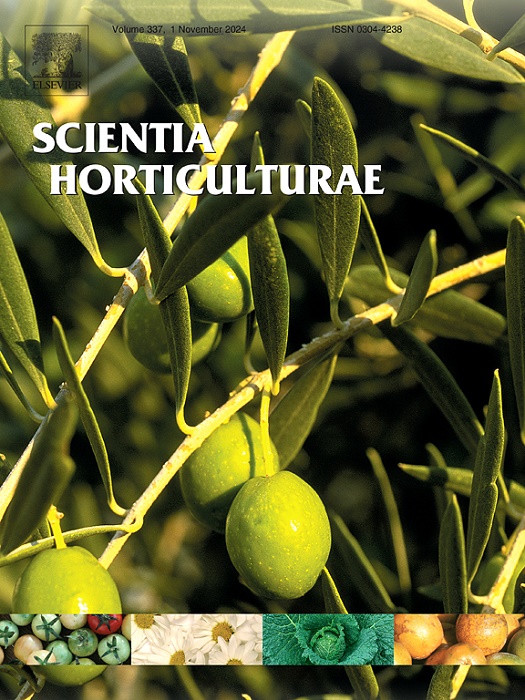蓝光感受器隐色素决定金针菇原基形成、子实体发育和菌毛开口
IF 3.9
2区 农林科学
Q1 HORTICULTURE
引用次数: 0
摘要
蓝光作为一种重要的环境因子,能够调控大型真菌的形态发育。受体WCC (white collar complex)在控制子实体伸长中起作用,但另一个重要受体隐花色素(cryptochrome)的重要作用却容易被忽视。在本研究中,我们研究了隐色素基因(FfCry)敲低对金针菇子实体形态发育的总体影响及其对代谢活性的下游调控。构建2个敲低菌株FfCry-kd8和FfCry-kd13,探讨FfCry敲低后的形态学变化。结果表明,ffcrry -kd8和ffcrry -kd13原基数量分别减少了33.6%和38.0%。与野生型(WT)相比,FfCry-kd8和FfCry-kd13的茎柱明显更短、更细(茎柱长度分别减少了51.8%和55.1%,茎柱直径分别减少了43.4%和34.6%)。特别是,两个FfCry-kd突变体的菌毛比WT小得多(直径分别减少了52.6%和55.9%),这意味着FfCry基因敲低抑制了菌毛的开放。RNA测序(RNA- seq)分析发现,FfCry基因敲除后,216个基因上调,164个基因下调。FfCry基因敲低主要激活葡聚糖1,3-β-葡萄糖苷酶、肽受体和β-丙氨酸代谢途径;同时主要抑制淀粉和蔗糖代谢,以及各种n -聚合物的生物合成和鞘脂代谢等。这些代谢途径在细胞壁的形成和细胞膜的流动性中起着重要作用。结果清楚地表明,在FfCry功能部分丧失的情况下,丝状连翘子实体形态发生了显著变化。这一发现对科学利用蓝光调控蘑菇的商业特性具有指导意义。本文章由计算机程序翻译,如有差异,请以英文原文为准。
Blue light receptor cryptochrome determines primordia formation, fruiting body development and pileus opening in macro mushroom Flammulina filiformis
Blue light, as a crucial environmental factor, can regulate the morphological development of macro fungi. The receptor WCC (white collar complex) has been found to play a role in controlling fruiting body elongation, but another important receptor, cryptochrome, was easily overlooked its important role. In this study, we investigated the overall impacts of cryptochrome gene (FfCry) knockdown on the morphological development of fruiting bodies and its downstream regulation of metabolic activities in Flammulina filiformis. Two knockdown strains FfCry-kd8 and FfCry-kd13 were constructed to explore the morphological changes after FfCry knockdown. The results showed that the number of primordia of FfCry-kd8 and FfCry-kd13 was reduced by 33.6 % and 38.0 %. Obviously, FfCry-kd8 and FfCry-kd13 showed much shorter and finer stipes (With stipe lengths reduced by 51.8 % and 55.1 %, and stipe diameters by 43.4 % and 34.6 %), compared with wild type (WT). Especially, two FfCry-kd transformants showed much smaller pileus than WT (diameter was decreased by 52.6 % and 55.9 %), meaning that FfCry knockdown inhibited the pileus opening. RNA Sequencing (RNA-Seq) analysis identified that 216 genes were up-regulated and 164 genes were down-regulated after FfCry knockdown. The FfCry gene knockdown primarily activated the glucan 1,3-β-glucosidase, peptide receptor, and β-alanine metabolic pathways; while mainly inhibiting starch and sucrose metabolism, as well as various N-polymer biosynthesis and sphingolipid metabolism, etc. These metabolic pathways played important roles in the formation of cell walls and the fluidity of cell membranes. The results clearly demonstrate the significant changes in the fruiting body morphology of F. filiformis in the case of partial loss of FfCry function. This finding holds guiding significance for the scientific utilization of blue light to regulate the commercial characteristics of mushrooms.
求助全文
通过发布文献求助,成功后即可免费获取论文全文。
去求助
来源期刊

Scientia Horticulturae
农林科学-园艺
CiteScore
8.60
自引率
4.70%
发文量
796
审稿时长
47 days
期刊介绍:
Scientia Horticulturae is an international journal publishing research related to horticultural crops. Articles in the journal deal with open or protected production of vegetables, fruits, edible fungi and ornamentals under temperate, subtropical and tropical conditions. Papers in related areas (biochemistry, micropropagation, soil science, plant breeding, plant physiology, phytopathology, etc.) are considered, if they contain information of direct significance to horticulture. Papers on the technical aspects of horticulture (engineering, crop processing, storage, transport etc.) are accepted for publication only if they relate directly to the living product. In the case of plantation crops, those yielding a product that may be used fresh (e.g. tropical vegetables, citrus, bananas, and other fruits) will be considered, while those papers describing the processing of the product (e.g. rubber, tobacco, and quinine) will not. The scope of the journal includes all horticultural crops but does not include speciality crops such as, medicinal crops or forestry crops, such as bamboo. Basic molecular studies without any direct application in horticulture will not be considered for this journal.
 求助内容:
求助内容: 应助结果提醒方式:
应助结果提醒方式:


